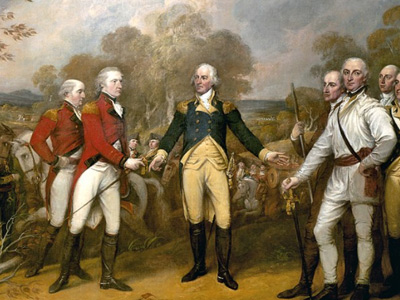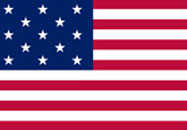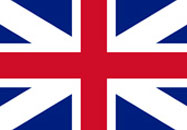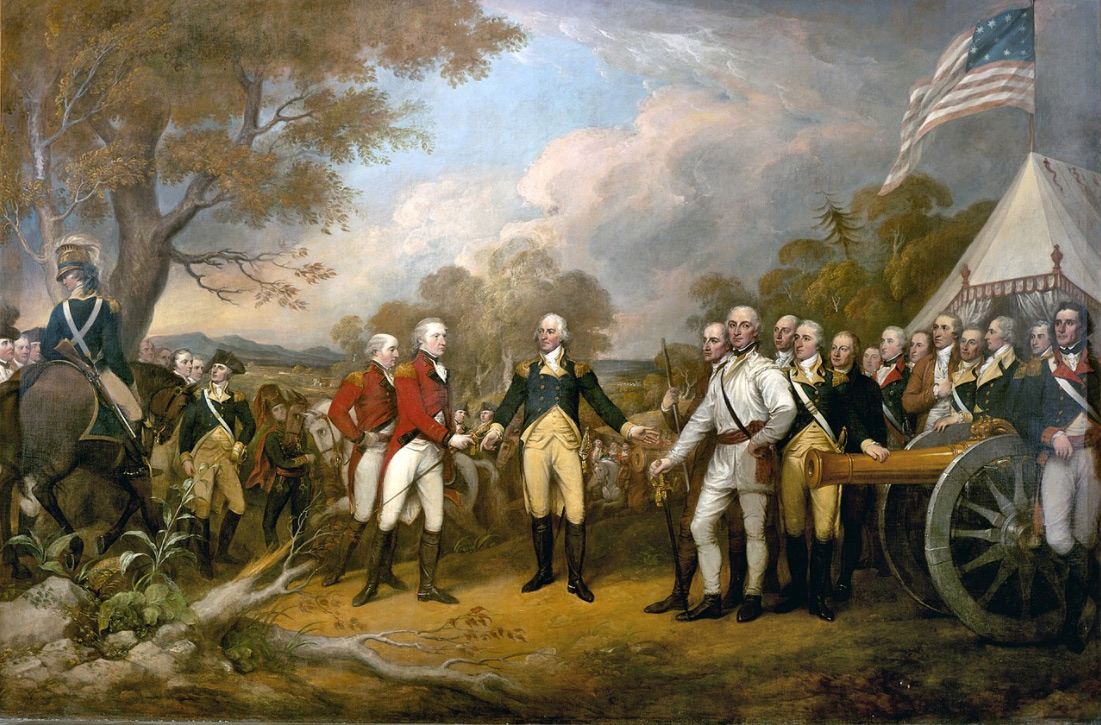Battles of Saratoga (1777)
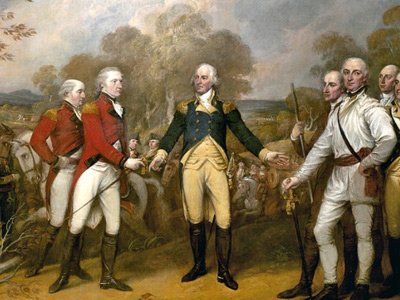
Aftermath
Burgoyne's failed campaign, as may be seen by the titles of some of the books that cover it in detail, marked a major turning point in the war. After the battle, he withdrew his men 10–15 miles north, near present-day Schuylerville, New York. General Burgoyne returned to England and was never given another commanding position in the British The Kingdom of Great Britain was a sovereign country in Western Europe from 1 May 1707 to the end of 31 December 1800. The state was created by the 1706 Treaty of Union and ratified by the Acts of Union 1707, which united the kingdoms of England (which included Wales) and Scotland to form a single kingdom encompassing the whole island of Great Britain and its outlying islands, with the exception of the Isle of Man and the Channel Islands. Army.
The Kingdom of Great Britain was a sovereign country in Western Europe from 1 May 1707 to the end of 31 December 1800. The state was created by the 1706 Treaty of Union and ratified by the Acts of Union 1707, which united the kingdoms of England (which included Wales) and Scotland to form a single kingdom encompassing the whole island of Great Britain and its outlying islands, with the exception of the Isle of Man and the Channel Islands. Army.
Armies and Casualties
Burgoyne lost 1,000 men in the two battles, leaving him outnumbered by roughly 3 to 1; American losses came to about 500 killed and wounded. Burgoyne had also lost several of his most effective leaders, his attempts to capture the American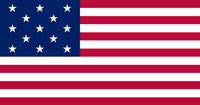 The United States of America (USA), is a country in North America. The American Revolutionary War (April 19, 1775 - September 3, 1783) was the military conflict in which American patriot forces under George Washington's command defeated the British, establishing and securing the independence of the United States. After the Revolution, the United States gained independence, the first nation-state founded on Enlightenment principles of liberal democracy. position had failed, and his forward line was now breached. That night he lit fires at his remaining forward positions and withdrew under the cover of darkness. On the morning of October 8, he was back in the fortified positions he had held on September 16. By October 13 he was surrounded at Saratoga, and on October 17 he surrendered his army. The remnants of his expedition retreated from Ticonderoga back to Quebec.
The United States of America (USA), is a country in North America. The American Revolutionary War (April 19, 1775 - September 3, 1783) was the military conflict in which American patriot forces under George Washington's command defeated the British, establishing and securing the independence of the United States. After the Revolution, the United States gained independence, the first nation-state founded on Enlightenment principles of liberal democracy. position had failed, and his forward line was now breached. That night he lit fires at his remaining forward positions and withdrew under the cover of darkness. On the morning of October 8, he was back in the fortified positions he had held on September 16. By October 13 he was surrounded at Saratoga, and on October 17 he surrendered his army. The remnants of his expedition retreated from Ticonderoga back to Quebec.
The British learned that the Americans would fight bravely and effectively. Said one British officer:
The courage and obstinacy with which the Americans fought were the astonishment of everyone, and we now became fully convinced that they are not that contemptible enemy we had hitherto imagined them, incapable of standing a regular engagement and that they would only fight behind strong and powerful works.
In recognition of his contribution to the battles at Saratoga, General Arnold had his seniority restored (he had lost it after being passed over for promotion earlier in 1777). His leg wound left Arnold bedridden for five months. Later, while still unfit for field service but serving as military governor of Philadelphia, Arnold entered into treasonous correspondence with the British. He received command of the fort at West Point and plotted to hand it over to the British, only to flee into the British lines when the capture of his contact John Andre led to the exposure of the plot. Arnold went on to serve under William Phillips, the commander of Burgoyne's right wing, in a 1781 expedition into Virginia.
Although he left the direction of the battle to subordinates, General Gates received a great deal of credit as the commanding general for the greatest American victory of the war to date. He may have conspired with others to replace George Washington as the commander-in-chief. Instead, he received the command of the main American army in the South. He led it to a disastrous defeat at the 1780 Battle of Camden, where he was at the forefront of a panicked retreat. Gates never commanded troops in the field again.
In response to Burgoyne's surrender, Congress declared December 18, 1777, as a national day "for solemn Thanksgiving and praise"; it was the nation's first official observance of a holiday with that name.
French Aid
Once news of Burgoyne's surrender reached France The Kingdom of France is the historiographical name or umbrella term given to various political entities of France in the medieval and early modern period. It was one of the most powerful states in Europe since the High Middle Ages. It was also an early colonial power, with possessions around the world. Colonial conflicts with Great Britain led to the loss of much of its North American holdings by 1763. The Kingdom of France adopted a written constitution in 1791, but the Kingdom was abolished a year later and replaced with the First French Republic., King Louis XVI decided to enter into negotiations with the Americans that resulted in a formal Franco-American alliance and French entry into the war. This moved the conflict onto a global stage. As a consequence, Britain was forced to divert resources used to fight the war in North America to theaters in the West Indies and Europe, and rely on what turned out to be the chimera of Loyalist support in its North American operations. Being defeated by the British in the French and Indian War more than a decade earlier, France found an opportunity of revenge by aiding the colonists throughout the Revolutionary War. Prior to the Battle of Saratoga, France didn't fully aid the colonists. However, after the Battles of Saratoga were conclusively won by the colonists, France realized that the Americans had the hope of winning the war, and began fully aiding the colonists by sending soldiers, donations, loans, military arms, and supplies.
The Kingdom of France is the historiographical name or umbrella term given to various political entities of France in the medieval and early modern period. It was one of the most powerful states in Europe since the High Middle Ages. It was also an early colonial power, with possessions around the world. Colonial conflicts with Great Britain led to the loss of much of its North American holdings by 1763. The Kingdom of France adopted a written constitution in 1791, but the Kingdom was abolished a year later and replaced with the First French Republic., King Louis XVI decided to enter into negotiations with the Americans that resulted in a formal Franco-American alliance and French entry into the war. This moved the conflict onto a global stage. As a consequence, Britain was forced to divert resources used to fight the war in North America to theaters in the West Indies and Europe, and rely on what turned out to be the chimera of Loyalist support in its North American operations. Being defeated by the British in the French and Indian War more than a decade earlier, France found an opportunity of revenge by aiding the colonists throughout the Revolutionary War. Prior to the Battle of Saratoga, France didn't fully aid the colonists. However, after the Battles of Saratoga were conclusively won by the colonists, France realized that the Americans had the hope of winning the war, and began fully aiding the colonists by sending soldiers, donations, loans, military arms, and supplies.
HISTORY
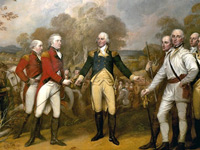
RESOURCES
This article uses material from the Wikipedia article "Battles of Saratoga (1777)", which is released under the Creative Commons Attribution-Share-Alike License 3.0.
© Stories Preschool. All Rights Reserved.
